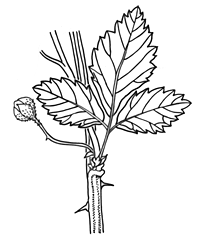Common name: Loganberry
Rubus loganobaccus L.H.Bailey APNI* Synonyms: Rubus ursinus Cham. & Schltdl. APNI*

Description: Spreading or climbing shrub to 5 m high when growing through supporting vegetation. Primocane stems rounded or scarcely angled, glabrous or with sparse non-glandular pilose hairs, prickles 3–6 mm long, not confined to angles. Flowering stems from the leaf axils of the floricane.
Primocane leaves pinnately compound, with 3, 5 or 7 leaflets, terminal leaflet 5.5–8 cm long, 3.5–6.5 cm wide; leaflets with sparse pilose hairs below, broadly-ovate to elliptic, petiole 3–8.5 cm long. Floricane leaves at base of flowering panicles consisting of 3 or 5 leaflets, lower surface of leaflets as for primocane leaflets, terminal leaflet mostly 4–10.5 cm long and 2.5–10.5 cm wide, petiole 3–6.5 cm long.
Inflorescence subcorymbose with 6–12 flowers. The first formed flowers usually solitary in the leaf axils of 3-leaflet leaves. Sepals rarely with prickles. Petals 12–18 mm long, 7–9 mm wide, elliptic, white, not crumpled. Stamens shorter than styles.
Fruit ovoid to oblong, initially green, ripening dark red to dull black.
Flowering: mainly late spring and summer.
Distribution and occurrence: not common. A stabilised hybrid between Rubus idaeus, raspberry and Rubus ursinus, the former being a native of Eurasia and the latter a native of the western coastal ranges of the U.S.A. Found in grasslands to forests.
NSW subdivisions: *CC, *ST
Other Australian states: *Vic. *S.A.
Distinguished by its pinnate primocane leaves, subcorymbose inflorescences and fruit ripening dark red to dull black. Introduced for its edible fruit.
Text by John Hosking, June 2009
Taxon concept: Evans et al., Australian Systematic Botany 20: 187-251 (2007)
APNI* Provides a link to the Australian Plant Name Index (hosted by the Australian National Botanic Gardens) for comprehensive bibliographic data
***The AVH map option provides a detailed interactive Australia wide distribution map drawn from collections held by all major Australian herbaria participating in the Australian Virtual Herbarium project.
|


